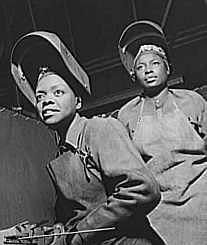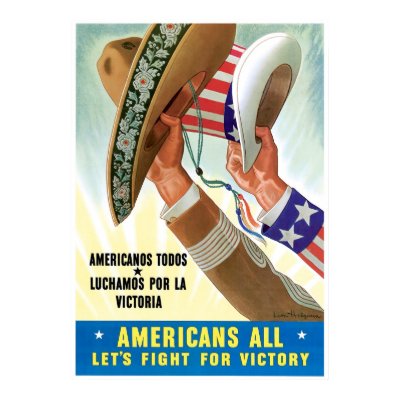Here is some more information from the American National Biography On-Line.
They credit four women with being Rosie. Surprisingly the most culturally diverse of them was an Italian, not a black or a hispanic.
Rosie the Riveter (fl. 1942-1945), Rose Will Monroe (1920-1997), and Rose Bonavita (1921-1966), iconic figure of the women who worked in defense industries during World War II, was a composite of the experiences of many real women, including Rose Bonavita, Rosalind P. Walter, Geraldine Hoff Doyle, and Rose Will Monroe.
During World War II the term "Rosie" was used to refer to all women who worked in defense industries and not just riveters.
The "Real" Rosies: Rose Bonavita
The composite figure of Rosie was based on a group of women, most of whom were named Rose, who varied in class, ethnicity, geography, and background. The daughter of Italian immigrants, Bonavita (1921-1966) worked as a riveter at the General Motors Eastern Aircraft Division in North Tarrytown, New York. She and her partner, Jennie Florio, set a production record by drilling nine hundred holes and driving thirty-three hundred rivets in the tail end of a Grumman TBF Avenger torpedo bomber during one six-hour overnight shift in June 1943. President Franklin D. Roosevelt later sent her a commendation letter. After the war, Bonavita married James Hickey and became a homemaker on Long Island.
The "Real" Rosies: Rosalind P. Walter
Another Long Island resident, Rosalind Palmer Walter (b. 1924), also worked as a riveter on the night shift on a Corsair, building the F4U marine gull-winged fighter airplane. She inspired "Rosie the Riveter," a 1942 song written by Redd Evans and John Jacob Loeb and recorded by the popular swing bandleader James Kern "Kay" Kyser. Like Bonavita, she left the factory after the war. Her family's wealth helped her become a local philanthropist and a trustee at Long Island University.
The "Real" Rosies: Geraldine Hoff Doyle
Geraldine Hoff Doyle (b. 1924) was the model for the We Can Do It! poster created by the graphic artist J. Howard Miller in 1942, which is often called the Rosie the Riveter poster. The daughter of an electric contractor and composer, she graduated from high school in Ann Arbor, Michigan. Immediately following graduation, Doyle had a temporary job as a metal presser in an Inkster, Michigan, defense factory. During her one week on the job, she was spotted and photographed by an unknown wire journalist. Miller transformed this photograph into a poster for the Westinghouse Electric Company, which did not employ riveters. As a shop poster intended to discourage absenteeism and strikes, it had a limited print run and was exhibited for only two weeks, to Westinghouse employees. Thus, Miller's Rosie poster did not depict a riveter, nor was it seen by many people during the war. Doyle married and became a homemaker after her brief stint in the factory. Miller's image became well known only in the early 1980s, when it was adopted by the emerging North American feminist movement as a symbol of female empowerment. During the first decade of the 2000s, the image was seen by a broader audience, and in 1982 Doyle finally discovered that she was the model for this poster.
The "Real" Rosies: Rose Will Monroe
Rose Will Monroe mid-1940s, Louisville
Courtesy of AP Images
Like Doyle, Rose Will Monroe also worked in a Michigan factory. In 1944 she was discovered at the Willow Run Aircraft Factory in Ypsilanti by the popular Canadian actor Walter Pidgeon. Pidgeon, who had starred in various wartime propaganda films, such as Mrs. Miniver (1942), visited Monroe's factory to shoot footage for films promoting the sale of war bonds. When Pidgeon met Monroe, she was working on the assembly line as a riveter of B-24 and B-49 bomber airplanes. Pidgeon's discovery matched a real Rosie with the national ideal, a relationship that received national attention in the promotional films that Monroe and Pidgeon made during the war. Because Monroe appeared as a Rosie the Riveter in these popular films, she is most often identified as the real Rosie the Riveter. In Monroe's New York Times obituary, her daughter Vicki Jarvis states, "Mom happened to be in the right place at the right time" (New York Times, 2 June 1997).
One of nine children born to a carpenter and a housewife in rural Science Hill, Kentucky, Monroe was skilled at her father's trade and defied traditional gender roles from a young age. According to Jarvis, her mother "was a tomboy who could use tools. She could do everything" (New York Times, 2 June 1997).
Like many Rosies, Monroe fled rural poverty to seek employment in more prosperous urban centers. When a car accident claimed the life of her first husband in 1942, Monroe and her two young children left Kentucky and traveled north, to the Willow Run factory. This factory trained female pilots to fly armaments around the country, and Monroe hoped to be chosen for this program. Because she was a single mother, however, she was not selected, and so her career consisted of assembling planes, rather than flying them.
The end of World War II meant the end of Monroe's assembly-line job, as it did for many Rosies. In 1945 she moved to Clarksville, Indiana, continuing to work outside the home for the rest of her life, unlike Bonavita, Walter, and Doyle. Monroe held a variety of jobs typically associated with women, such as seamstress and beauty shop owner, as well as the more unconventional positions of taxi driver and school bus driver. Following a stint as a real-estate agent, Monroe realized that she knew how to build homes, so she founded Rose Builders, a construction company that specialized in luxury homes. At the age of fifty, Monroe finally earned her pilot's license and went on to become the only woman in her local aeronautics club. She also taught her younger daughter how to fly. In 1978 Monroe was in a plane accident that resulted in the loss of a kidney, a contributing factor to her death in 1997.
Bonavita, Walter, Doyle, and Monroe were some of the 6 million women who entered the workforce during the war, half of whom were employed by defense industries. In January 1942 President Roosevelt called for accelerated industrial production. He asked women to join the effort, forming the War Manpower Commission (WMC) and the Office of War Information (OWI), government agencies dedicated to increasing women's participation in all sectors of the workforce. The WMC and OWI intensified their employment efforts by creating the Women in Necessary Service and Women in War campaigns, in preparation for the June 1944 D-Day campaign. Photographs of female industrial workers appeared in 1943 and 1944 issues of Life, National Geographic, and Fortune magazines.
Rosie in Art and Popular Culture
Artists and filmmakers also celebrated women war workers. In 1943 Norman Rockwell created his painting of Rosie the Riveter, which appeared on the cover of the Memorial Day issue of the Saturday Evening Post. In this image a muscular Rosie takes a sandwich break, with her feet resting on a copy of Hitler's Mein Kampf, while her riveting gun is temporarily idle. This image of Rosie was hypothetical, based on Michelangelo's Isaiah from the Sistine Chapel, and the model was not a riveter, but a dental hygienist, Mary Keefe. The Saturday Evening Post donated Rockwell's popular painting to the Second War Loan Drive, which traveled the United States to encourage the purchase of war bonds. Movies such as Swing Shift Maisie (1943) featured Ann Sothern as an aircraft worker, while Lucille Ball played a defense plant worker in Meet the People (1944), and Claudette Colbert starred as a welder in Since You Went Away (1944). Women war workers were also the subject of a Broadway play, Rosie the Riveter, as well as Augusta H. Clawson's memoir Shipyard Diary of a Woman Welder (1944). Unlike Rockwell's Rosie, many of the images of Rosie in popular culture depicted her as hyperfeminine, reflecting a concern that industrial work would erode a woman's femininity.
Although Bonavita, Walter, Doyle, and Monroe inspired the popular Rosie the Riveter iconography, their fame and financial independence were short-lived. Like a majority of female war workers, Bonavita, Walter, and Doyle exited the workforce by the end of the war. Many women who worked in defense industries during World War II did so out of economic necessity and for patriotic reasons, not to achieve gender equality.
Since the last two decades of the twentieth century, both real and fictive Rosies have increased in popularity. In 1980 the director Connie Field made a documentary titled The Life and Times of Rosie the Riveter. During the early twenty-first century, Miller's Rosie poster became one of the ten most requested images from the National Archives. On 14 October 2000 the Rosie the Riveter Memorial (designed by Susan Schwartzenberg and Cheryl Barton) was dedicated on the site of the former Kaiser Shipyard Number 2, in Richmond, California, where women built a warship in a record-breaking four days. Interviews of several real-life Rosies are also included in Ken Burns's series The War (2007).
--------------------------------------------------------------------------------
Bibliography
The only source for Rose Will Monroe is her 2 June 1997 obituary in the New York Times. Most of the sources on Rosie the Riveter do not focus on an individual "Rosie." These include Maureen Honey's Creating Rosie the Riveter: Class, Gender, and Propaganda during World War II (1984), which examines how various government agencies encouraged working and middle-class women to enter the industrial work force, and Penny Colman's Rosie the Riveter: Women Working on the Home Front in World War II (1995), which provides many statistics and photographs of women in the industrial and civilian workforces during World War II. In 1982 Connie Field published, with Miriam Frank and Mirlyn Ziebarth, The Life and Times of Rosie the Riveter: The Story of Three Million Working Women during World War II, based on her 1980 documentary film.
Heidi A. Strobel
There may have been far many more hispanics, asians and blacks working in these factories as archetypal Rosies, but none of them can lay claim to being the 'real' Rosie.








